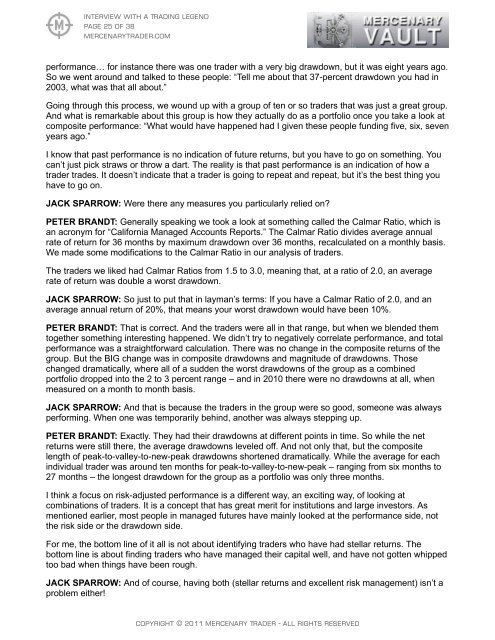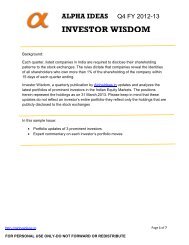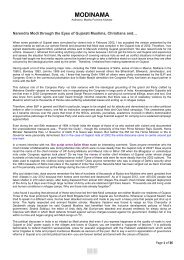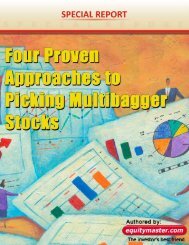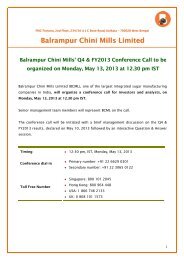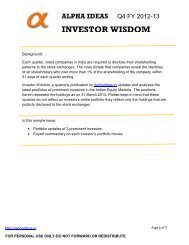Interview With a Trading Legend - Mercenary Trader
Interview With a Trading Legend - Mercenary Trader
Interview With a Trading Legend - Mercenary Trader
You also want an ePaper? Increase the reach of your titles
YUMPU automatically turns print PDFs into web optimized ePapers that Google loves.
<strong>Interview</strong> <strong>With</strong> a <strong>Trading</strong> <strong>Legend</strong><br />
Page 25 of 38<br />
mercenarytrader.com<br />
performance… for instance there was one trader with a very big drawdown, but it was eight years ago.<br />
So we went around and talked to these people: “Tell me about that 37-percent drawdown you had in<br />
2003, what was that all about.”<br />
Going through this process, we wound up with a group of ten or so traders that was just a great group.<br />
And what is remarkable about this group is how they actually do as a portfolio once you take a look at<br />
composite performance: “What would have happened had I given these people funding five, six, seven<br />
years ago.”<br />
I know that past performance is no indication of future returns, but you have to go on something. You<br />
can’t just pick straws or throw a dart. The reality is that past performance is an indication of how a<br />
trader trades. It doesn’t indicate that a trader is going to repeat and repeat, but it’s the best thing you<br />
have to go on.<br />
JACK SPARROW: Were there any measures you particularly relied on?<br />
PETER BRANDT: Generally speaking we took a look at something called the Calmar Ratio, which is<br />
an acronym for “California Managed Accounts Reports.” The Calmar Ratio divides average annual<br />
rate of return for 36 months by maximum drawdown over 36 months, recalculated on a monthly basis.<br />
We made some modifications to the Calmar Ratio in our analysis of traders.<br />
The traders we liked had Calmar Ratios from 1.5 to 3.0, meaning that, at a ratio of 2.0, an average<br />
rate of return was double a worst drawdown.<br />
JACK SPARROW: So just to put that in layman’s terms: If you have a Calmar Ratio of 2.0, and an<br />
average annual return of 20%, that means your worst drawdown would have been 10%.<br />
PETER BRANDT: That is correct. And the traders were all in that range, but when we blended them<br />
together something interesting happened. We didn’t try to negatively correlate performance, and total<br />
performance was a straightforward calculation. There was no change in the composite returns of the<br />
group. But the BIG change was in composite drawdowns and magnitude of drawdowns. Those<br />
changed dramatically, where all of a sudden the worst drawdowns of the group as a combined<br />
portfolio dropped into the 2 to 3 percent range – and in 2010 there were no drawdowns at all, when<br />
measured on a month to month basis.<br />
JACK SPARROW: And that is because the traders in the group were so good, someone was always<br />
performing. When one was temporarily behind, another was always stepping up.<br />
PETER BRANDT: Exactly. They had their drawdowns at different points in time. So while the net<br />
returns were still there, the average drawdowns leveled off. And not only that, but the composite<br />
length of peak-to-valley-to-new-peak drawdowns shortened dramatically. While the average for each<br />
individual trader was around ten months for peak-to-valley-to-new-peak – ranging from six months to<br />
27 months – the longest drawdown for the group as a portfolio was only three months.<br />
I think a focus on risk-adjusted performance is a different way, an exciting way, of looking at<br />
combinations of traders. It is a concept that has great merit for institutions and large investors. As<br />
mentioned earlier, most people in managed futures have mainly looked at the performance side, not<br />
the risk side or the drawdown side.<br />
For me, the bottom line of it all is not about identifying traders who have had stellar returns. The<br />
bottom line is about finding traders who have managed their capital well, and have not gotten whipped<br />
too bad when things have been rough.<br />
JACK SPARROW: And of course, having both (stellar returns and excellent risk management) isn’t a<br />
problem either!<br />
Copyright © 2011 <strong>Mercenary</strong> <strong>Trader</strong> - All Rights Reserved


